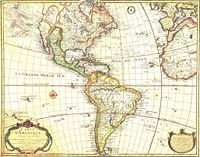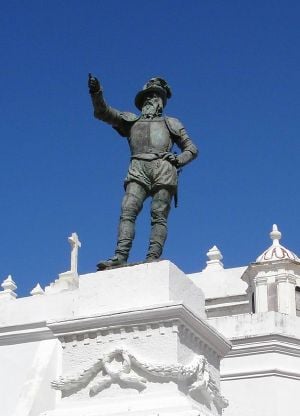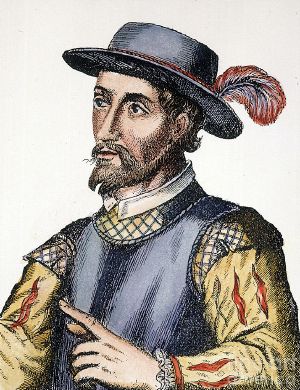Juan Ponce de León
Juan Ponce de León (c. 1460 – July 1521[1]) was a Spanish conquistador. He was born in Santervás de Campos (Valladolid). As a young man he joined the war to conquer Granada, the last Moorish state on the Iberian peninsula. Ponce de León accompanied Christopher Columbus on his second voyage to the New World. He became the first Governor of Puerto Rico by appointment of the Spanish Crown. He is also notable for his voyage to Florida, the first known European excursion there, as well as for being associated with the legend of the Fountain of Youth.
Arrival in the New World
It is thought that Ponce de León first landed on the site where Cockburn Town is, on Grand Turk in the Turks & Caicos Islands but soon settled in Hispaniola. He helped conquer the Tainos of the eastern part of Hispaniola and was rewarded with the governorship of the Province of Higuey that was created there. While there, he heard stories of the wealth of Borinquen (now Puerto Rico), and he sought and received permission to go there.
In 1508, Ponce de León founded the first settlement in Puerto Rico, Caparra. He was greeted with open arms by the Taino Cacique Agüeybaná and quickly gained control of the island. As a result, Ponce de León was named Governor of Puerto Rico in 1509. Ponce de León and the other conquistadors forced the Tainos to work in the mines and to construct fortifications. The Tainos died in great numbers after exposure to the European diseases the sailors brought with them, to which they had no immunity. Ponce de León, however, became rich while serving as Governor.[2] He married a Spanish woman named Leonore and had two daughters and one son.
Removal from office as governor of Puerto Rico

|
| Spanish colonization of the Americas |
| History of the conquest |
|
Inter caetera |
| Conquistadores |
|
Vasco Núñez de Balboa |
In 1506, upon the death of Christopher Columbus, who had been appointed lifetime military governor of his discoveries, the Spanish authorities refused to grant the same privilege to his son Diego Columbus. The Spanish Crown by then had selected Ponce de León to colonize and govern the island of Puerto Rico. In the meantime Diego Columbus had taken his claim to the top court in Madrid and won his rights: Ponce de León was removed from office in 1511. Feeling that his good name had been damaged and not wishing to serve Diego, Ponce de León obtained title to explore the areas north of Cuba.[3]
The Fountain of Youth
According to a popular legend Ponce de León discovered Florida while searching for the Fountain of Youth. Though stories of vitality-restoring waters were known on both sides of the Atlantic long before Ponce de León, the story of him searching for them was not attached to him until after his death. In his Historia General y Natural de las Indias of 1535, Gonzalo Fernández de Oviedo wrote that Ponce de León was looking for the waters of Bimini to cure his sexual impotence.[4] A similar account appears in Francisco López de Gómara's Historia General de las Indias of 1551.[5] Then in 1575, Hernando de Escalante Fontaneda, a shipwreck survivor who had lived with the Indians of Florida for 17 years, published his memoir in which he locates the waters in Florida, and says that Ponce de León was supposed to have looked for them there.[6] Though Fontaneda doubted that de León had really gone to Florida looking for the waters, the account was included in the Historia general de los hechos de los Castellanos of Antonio de Herrera y Tordesillas of 1615.

First voyage and discovery of Florida
Ponce de León equipped three ships at his own expense, and set out on his voyage of discovery and conquest in 1513. On March 27, 1513, he sighted an island, but sailed on without landing. On April 2 he landed on the east coast of the newly "discovered" land at a point which is disputed, but was somewhere on the northeast coast of the present State of Florida. Ponce de León claimed "La Florida" for Spain. He named the land La Florida, meaning flowery, either because of the vegetation in bloom he saw there, or because he landed there during Pascua Florida, Spanish for Flowery Passover, meaning the Easter season.[2][3] Pascua Florida Day, April 2, is a legal holiday in Florida[7].
Ponce de León then sailed south along the Florida coast, charting the rivers he found, passed around the Florida Keys, and up the west coast of Florida to Cape Romano. He sailed back south to Havana, and then up to Florida again, stopping at the Bay of Chequesta (Biscayne Bay) before returning to Puerto Rico.[2]
Ponce de León may not have been the first European to reach Florida. He encountered at least one Native American in Florida in 1513 who could speak Spanish[8].
Return to Spain
In 1514 Ponce de León returned to Spain and received commissions to conquer the Caribs of Guadalupe and to colonize the Island of Florida. His expedition to Guadalupe in 1515 was not successful, and he returned to Puerto Rico where he stayed until 1521.[2]
Last voyage to Florida
In 1521 Ponce de León organized a colonizing expedition on two ships. It consisted of some 200 men, including priests, farmers and artisans, 50 horses and other domestic animals, and farming implements. The expedition landed on the southwest coast of Florida, somewhere in the vicinity of the Caloosahatchee River or Charlotte Harbor. The colonists were soon attacked by Calusas and Ponce de León was injured by a poisoned arrow to the shoulder. After this attack, he and colonists sailed to Havana, Cuba, where he soon died of the wound. His tomb is in the cathedral in Old San Juan.[2][3]
Notes
- ↑ Webster's Biographical Dictionary, 1st edition, 1961, G & C. Merriam Co., p. 1200. Ponce de León's year of birth is uncertain.
- ↑ 2.0 2.1 2.2 2.3 2.4 Ponce de Leon, Juan. The Columbia Electronic Encyclopedia, 6th ed. 2005. Columbia University Press. - accessed December 28 2005
- ↑ 3.0 3.1 3.2 Florida of the Conquistador - accessed December 27 2005
- ↑ Gonzalo Fernández de Oviedo. Historia General y Natural de las Indias, book 16, chapter XI.
- ↑ Francisco López de Gómara. Historia General de las Indias, second part.
- ↑ "Fontaneda's Memoir". Translation by Buckingham Smith, 1854. From keyshistory.org. Retrieved March 28, 2007.
- ↑ The 2005 Florida Statutes - Chapter 683 - LEGAL HOLIDAYS; SPECIAL OBSERVANCES - accessed December 27 2005
- ↑ Smith, Hale G. and Marc Gottlob. 1978. Spanish-Indian Relationships: Synoptic History and Archaeological Evidence, 1500-1763, in Milanich, Jerald and Samuel Proctor. Tacachale: Essays on the Indians of Florida and Southeastern Georgia during the Historic Period. Gainesville, Florida: The University Presses of Florida. ISBN 0-8130-0535-3
ReferencesISBN links support NWE through referral fees
Credits
New World Encyclopedia writers and editors rewrote and completed the Wikipedia article in accordance with New World Encyclopedia standards. This article abides by terms of the Creative Commons CC-by-sa 3.0 License (CC-by-sa), which may be used and disseminated with proper attribution. Credit is due under the terms of this license that can reference both the New World Encyclopedia contributors and the selfless volunteer contributors of the Wikimedia Foundation. To cite this article click here for a list of acceptable citing formats.The history of earlier contributions by wikipedians is accessible to researchers here:
The history of this article since it was imported to New World Encyclopedia:
Note: Some restrictions may apply to use of individual images which are separately licensed.


